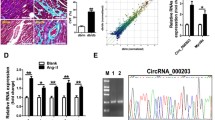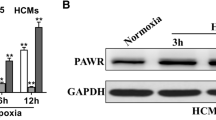Abstract
Increasing evidence has shown that circular RNAs (circRNAs) participate in the process of cardiac remodeling. CircRNA circ_0036176 originating from the back-splicing of exon 2 to exon4 of myosin IXA (Myo9a) gene was shown to be increased in the myocardium of patients with heart failure (HF) and riched in exosomes from human AC16 cardiomyocytes with overexpression of circ_0036176. Proliferation activity was inhibited in mCFs subjected to exosomal circ_0036176 treatment and in mCFs with overexpression of circ_0036176. Interestingly, circ_0036176 contains an IRES element and an ORF of 627 nt encoding a 208-amino acid protein (termed as Myo9a-208). Myo9a-208 was shown to mediate the inhibitory effect of circ_0036176 on CFs proliferation, and miR-218-5p could inhibit Myo9a-208 expression by binding to circ_0036176, resulting in abolishing the effect of circ_0036176 on inactivating cyclin/Rb signal and suppressing CFs proliferation. Our findings suggest that circ_0036176 inhibits mCFs proliferation by translating Myo9a-208 protein to suppress cyclin/Rb pathway.
Graphical abstract







Similar content being viewed by others
Abbreviations
- Ang-II:
-
Angiotensin-II
- CCK8:
-
Cell Counting Kit-8
- CCND1:
-
Cyclin D1
- CCNE1:
-
Cyclin E1
- CDK6:
-
Cyclin kinase 6
- CDK9:
-
Cyclin kinase 9
- circRNAs:
-
Circular RNAs
- CVF:
-
Collagen volume fraction
- ECM:
-
Extracellular matrix
- EdU:
-
5-Ethynyl-2′-deoxyuridine
- FL:
-
Firefly luciferase
- HAFs:
-
Human atrial fibroblasts
- HF:
-
Heart failure
- IRES:
-
Internal ribosome entry sites
- mCFs:
-
Mouse cardiac fibroblasts
- MIRESs:
-
M6A-induced ribosome engagement sites
- miR:
-
MicroRNA
- MYO9A:
-
Myosin IXA
- ORF:
-
Open reading frame
- p-HH3:
-
Phosphorylated histone H3
- p-Rb1:
-
Phosphorylated RB transcriptional corepressor 1
- RL:
-
Renilla luciferase
- RT-qPCR:
-
Quantitative reverse-transcription PCR
- TEM:
-
Transmission electron microscope
- 3′-UTR:
-
3′ Untranslated region
References
Frangogiannis, N. G. (2019). Cardiac fibrosis: Cell biological mechanisms, molecular pathways and therapeutic opportunities. Molecular Aspects of Medicine, 65, 70–99.
Berk, B. C., Fujiwara, K., & Lehoux, S. (2007). ECM remodeling in hypertensive heart disease. The Journal of Clinical Investigation, 117, 568–575.
Krenning, G., Zeisberg, E. M., & Kalluri, R. (2010). The origin of fibroblasts and mechanism of cardiac fibrosis. Journal of Cellular Physiology, 225, 631–637.
Souders, C. A., Bowers, S. L. K., & Baudino, T. A. (2009). Cardiac fibroblast the renaissance cell. Circulation Research, 105, 1164–1176.
Eghbali, M., Blumenfeld, O. O., Seifter, S., Buttrick, P. M., Leinwand, L. A., Robinson, T. F., et al. (1989). Localization of types I, III and IV collagen mRNAs in rat heart cells by in situ hybridization. Journal of Molecular and Cellular Cardiology, 21, 103–113.
Brown, R. D., Ambler, S. K., Mitchell, M. D., & Long, C. S. (2005). The cardiac fibroblast: Therapeutic target in myocardial remodeling and failure. Annual Review of Pharmacology and Toxicology, 45, 657–687.
Spinale, F. G. (2007). Myocardial matrix remodeling and the matrix metalloproteinases: Influence on cardiac form and function. Physiological Reviews, 87, 1285–1342.
Turner, N. A. (2011). Therapeutic regulation of cardiac fibroblast function: Targeting stress-activated protein kinase pathways. Future Cardiology, 7, 673–691.
Cleutjens, J. P., Verluyten, M. J., Smiths, J. F., & Daemen, M. J. (1995). Collagen remodeling after myocardial infarction in the rat heart. American Journal of Pathology, 147, 325–338.
Ashizawa, N., Graf, K., Do, Y. S., Nunohiro, T., Giachelli, C. M., Meehan, W. P., et al. (1996). Osteopontin is produced by rat cardiac fibroblasts and mediates A(II)-induced DNA synthesis and collagen gel contraction. The Journal of Clinical Investigation, 98, 2218–2227.
Komatsubara, I., Murakami, T., Kusachi, S., Nakamura, K., Hirohata, S., Hayashi, J., et al. (2003). Spatially and temporally different expression of osteonectin and osteopontin in the infarct zone of experimentally induced myocardial infarction in rats. Cardiovascular Pathology, 12, 186–194.
Cleutjens, J. P., Kandala, J. C., Guarda, E., Guntaka, R. V., & Weber, K. T. (1995). Regulation of collagen degradation in the rat myocardium after infarction. Journal of Molecular and Cellular Cardiology, 27, 1281–1292.
Li, B., Li, Y., Hu, L., Liu, Y., Zhou, Q., Wang, M., et al. (2020). Role of circular RNAs in the pathogenesis of cardiovascular disease. Journal of Cardiovascular Translational Research, 13, 572–583.
Creemers, E. E., & van Rooij, E. (2016). Function and therapeutic potential of noncoding RNAs in cardiac fibrosis. Circulation Research, 118, 108–118.
Yousefi, F., & Soltani, B. M. (2021). Circular RNAs as potential theranostics in the cardiac fibrosis. Heart Failure Reviews, 26, 195–203.
Huang, C., & Shan, G. (2015). What happens at or after transcription: Insights into circRNA biogenesis and function. Transcription, 6, 61–64.
Li, Y., Zheng, Q., Bao, C., Li, S., Guo, W., Zhao, J., et al. (2015). Circular RNA is enriched and stable in exosomes: A promising biomarker for cancer diagnosis. Cell Research, 25, 981–984.
Zhang, C., Huo, S. T., Wu, Z., Chen, L., Wen, C., Chen, H., et al. (2020). Rapid development of targeting circRNAs in cardiovascular diseases. Molecular Therapy Nucleic Acids, 21, 568–576.
Tang, C. M., Zhang, M., Huang, L., Hu, Z. Q., Zhu, J. N., **ao, Z., et al. (2017). CircRNA_000203 enhances the expression of fibrosis-associated genes by derepressing targets of miR-26b-5p, Col1a2 and CTGF, in cardiac fibroblasts. Science and Reports, 7, 40342.
Wu, N., Xu, J., Du, W. W., Li, X., Awan, F. M., Li, F., et al. (2021). YAP circular RNA, circYap, attenuates cardiac fibrosis via binding with tropomyosin-4 and gamma-actin decreasing actin polymerization. Molecular Therapy, 29, 1138–1150.
Wu, N., Li, C., Xu, B., **ang, Y., Jia, X., Yuan, Z., et al. (2021). Circular RNA mmu_circ_0005019 inhibits fibrosis of cardiac fibroblasts and reverses electrical remodeling of cardiomyocytes. BMC Cardiovascular Disorders, 21, 308.
Wang, K., Long, B., Liu, F., Wang, J. X., Liu, C. Y., Zhao, B., et al. (2016). A circular RNA protects the heart from pathological hypertrophy and heart failure by targeting miR-223. European Heart Journal, 37, 2602–2611.
Wang, K., Gan, T. Y., Li, N., Liu, C. Y., Zhou, L. Y., Gao, J. N., et al. (2017). Circular RNA mediates cardiomyocyte death via miRNA dependent upregulation of MTP18 expression. Cell Death and Differentiation, 24, 1111–1120.
Du, W. W., Xu, J., Yang, W., Wu, N., Li, F., Zhou, L., et al. (2021). A neuroligin isoform translated by circNlgn contributes to cardiac remodeling. Circulation Research, 129, 568–582.
Yang, Z., **ao, Z., Guo, H., Fang, X., Liang, J., Zhu, J., et al. (2019). Novel role of the clustered miR-23b-3p and miR-27b-3p in enhanced expression of fibrosis-associated genes by targeting TGFBR3 in atrial fibroblasts. Journal of Cellular and Molecular Medicine, 23, 3246–3256.
Zeng, N., Huang, Y. Q., Yan, Y. M., Hu, Z. Q., Zhang, Z., Feng, J. X., et al. (2021). Diverging targets mediate the pathological role of miR-199a-5p and miR-199a-3p by promoting cardiac hypertrophy and fibrosis. Molecular Therapy Nucleic Acids, 26, 1035–1050.
Yuan, W. W., Tang, C. M., Zhu, W. S., Zhu, J. N., Lin, Q. X., Fu, Y. H., et al. (2016). CDK6 mediates the effect of attenuation of miR-1 on provoking cardiomyocyte hypertrophy. Molecular and Cellular Biochemistry, 412, 289–296.
Zhu, W. S., Tang, C. M., **ao, Z., Zhu, J. N., Lin, Q. X., Fu, Y. H., et al. (2016). Targeting EZH1 and EZH2 contributes to the suppression of fibrosis-associated genes by miR-214-3p in cardiac myofibroblasts. Oncotarget, 7, 78331–78342.
Tang, C. M., Liu, F. Z., Zhu, J. N., Fu, Y. H., Lin, Q. X., Deng, C. Y., et al. (2016). Myocyte-specific enhancer factor 2C: A novel target gene of miR-214-3p in suppressing angiotensin II-induced cardiomyocyte hypertrophy. Science and Reports, 6, 36146.
Behbehani, G. K. (2018). Cell cycle analysis by mass cytometry. Methods in Molecular Biology, 1686, 105–124.
Wang, Y., Liu, J., Ma, J., Sun, T., Zhou, Q., Wang, W., et al. (2019). Exosomal circRNAs: Biogenesis, effect and application in human diseases. Molecular Cancer, 18, 116.
Henning, R. J. (2021). Cardiovascular exosomes and microRNAs in cardiovascular physiology and pathophysiology. Journal of Cardiovascular Translational Research, 14, 195–212.
Shi, Y., Jia, X., & Xu, J. (2020). The new function of circRNA: Translation. Clinical and Translational Oncology, 22, 2162–2169.
Prats, A. C., David, F., Diallo, L. H., Roussel, E., Tatin, F., Garmy-Susini, B., et al. (2020). Circular RNA, the key for translation. International Journal of Molecular Sciences, 21, 8591.
Kristensen, L. S., Andersen, M. S., Stagsted, L. V. W., Ebbesen, K. K., Hansen, T. B., & Kjems, J. (2019). The biogenesis, biology and characterization of circular RNAs. Nature Reviews Genetics, 20, 675–691.
Miska, E. A. (2005). How microRNAs control cell division, differentiation and death. Current Opinion in Genetics & Development, 15, 563–568.
Ke, X., Yang, R., Wu, F., Wang, X., Liang, J., Hu, X., et al. (2021). Exosomal miR-218-5p/miR-363-3p from endothelial progenitor cells ameliorate myocardial infarction by targeting the p53/JMY signaling pathway. Oxidative Medicine and Cellular Longevity, 2021, 5529430.
Chen, M., Li, M., Zhang, N., Sun, W., Wang, H., & Wei, W. (2021). Mechanism of miR-218-5p in autophagy, apoptosis and oxidative stress in rheumatoid arthritis synovial fibroblasts is mediated by KLF9 and JAK/STAT3 pathways. Journal of Investigative Medicine, 69, 824–832.
Meinsohn, M. C., Morin, F., Bertolin, K., Duggavathi, R., Schoonjans, K., & Murphy, B. D. (2017). The orphan nuclear receptor liver homolog receptor-1 (Nr5a2) regulates ovarian granulosa cell proliferation. Journal of the Endocrine Society, 2, 24–41.
Sobecki, M., Mrouj, K., Colinge, J., Gerbe, F., Jay, P., Krasinska, L., et al. (2017). Cell-cycle regulation accounts for variability in Ki-67 expression levels. Cancer Research, 77, 2722–2734.
Shao, Y. Y., Li, Y. S., Hsu, H. W., Lin, H., Wang, H. Y., Wo, R. R., et al. (2019). Potent activity of composite cyclin dependent kinase inhibition against hepatocellular carcinoma. Cancers (Basel), 11, 1433.
Saavedra, H. I., Wu, L., de Bruin, A., Timmers, C., Rosol, T. J., Weinstein, M., et al. (2002). Specificity of E2F1, E2F2, and E2F3 in mediating phenotypes induced by loss of Rb. Cell Growth & Differentiation, 13, 215–225.
Funding
This study was funded by the National Natural Science Foundation of China (82070254 and 81770264 to Z.-X. Shan), a High-level Hospital Construction Project of Guangdong Provincial People’s Hospital (DFJH201902 to Z.-X. Shan), Guangdong Basic and Applied Basic Research Foundation (2021A1515011554 to X.-H. Fang), and Guangzhou Science and Technology Program project (202002030013 to X.-H. Fang, 202002030039 to H.-M. Guo).
Author information
Authors and Affiliations
Contributions
Conceived and designed the experiments: **g Guo and Zhi-**n Shan. Performed the experiments: **g Guo, Li-Wen Chen, Zhi-Qi Huang, Ji-Shen Guo, Yue Shan, and Jie-Ning Zhu. Managed data: Zhi-Qi Huang and Hui Li. Analyzed the data: Hui-Ming Guo and Zhi-**n Shan. Contributed reagents/materials/analysis tools: Yu-Min Yan, Ze-Run Chen, and **an-Hong Fang. Funding acquisition: **an-Hong Fang, Hui-Ming Guo, and Zhi-**n Shan. Wrote the paper: Zhi-**n Shan. All authors have read and agreed to the final version of manuscript.
Corresponding authors
Ethics declarations
Conflict of Interest
The authors declare no competing interests.
Additional information
Associate Editor Junjie **ao oversaw the review of this article.
Publisher's Note
Springer Nature remains neutral with regard to jurisdictional claims in published maps and institutional affiliations.
Supplementary Information
Below is the link to the electronic supplementary material.
Rights and permissions
About this article
Cite this article
Guo, J., Chen, LW., Huang, ZQ. et al. Suppression of the Inhibitory Effect of circ_0036176-Translated Myo9a-208 on Cardiac Fibroblast Proliferation by miR-218-5p. J. of Cardiovasc. Trans. Res. 15, 548–559 (2022). https://doi.org/10.1007/s12265-022-10228-x
Received:
Accepted:
Published:
Issue Date:
DOI: https://doi.org/10.1007/s12265-022-10228-x




